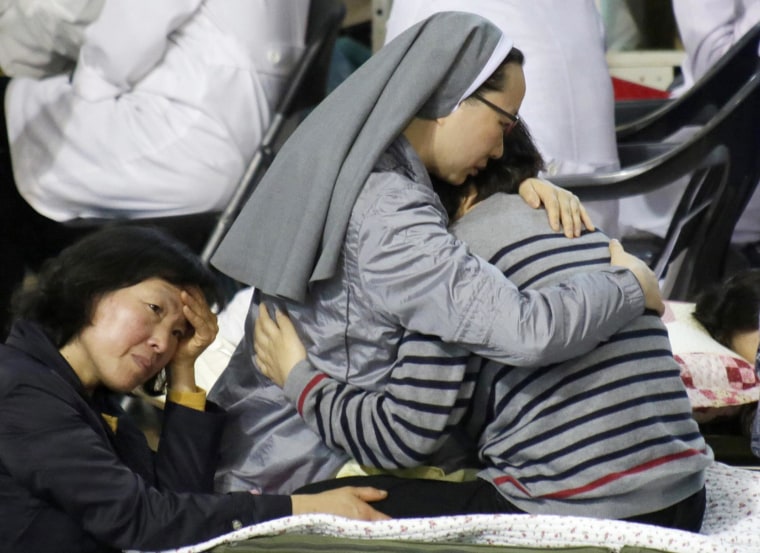JINDO, South Korea — Here in a gymnasium where teenagers normally compete in raucous games of basketball, the scoreboard is blank and the hall is filled with very different sounds: cries of mourning for teenagers who will never play again.
This is where the parents and relatives of the missing wait for news of their submerged children. It is a mosaic of misery — multi-colored blankets wrap hundreds of grief-stricken, sobbing men and women of all ages.
"I want to die, to be with my son... but I must live for my daughter."
And as the death toll from Wednesday's ferry disaster off the coast of South Korea rises, the anguish deepens.
The Sewol sank with 476 people on board. Teenagers on an annual high school trip make up only 75 of 174 survivors, and about 225 of the missing.
At least 23 of the 59 confirmed dead are teenage students, coast guard spokesman Kim Jae-in told The Associated Press. An NBC News correspondent saw authorities bringing five more bodies ashore early Monday mornings.
One by one, the children are being identified by descriptions of height, hair and clothes and victim number displayed on a screen:
"Child #55, #56; both boys. Child #53; black T-shirt, green North Face jacket, G-Shock watch."
The raw details stir deep emotions. There are terrible cries from several women on the floor.
VIDEO: Ferry Disaster Likely Won't Have Any More Survivors
"My child was alive in the water, I had a text message," one screams. Other parents merely have a look of utter fatigue and resignation. They now accept their children are probably dead.
Lee Young Ock lost her 17-year-old son. "Actually I want to die, to be with my son," she said in a halting, weary voice, "but I must live for my daughter."
Outside the gym, Choi Young Kyung, an uncle of one of the missing, says "most people already gave up."
After five days of clinging to hope that, somehow, their children might have survived in an air pocket, he says most have now accepted they'll never see their kids alive again.

Many parents — in a country where the birth rate is very low — have only one child. Their loss is complete.
Most just want the victims out of the water. They want to see their children one final time before they become too deformed by the sea.
My child was alive in the water, I had a text message!
Others have had enough. They marched for miles in protest, heading for a confrontation with Korean officials who, they say, delayed the rescue operation for so long that their children died unnecessarily.
Police blockaded the group, leading to scuffles.
"Please help us", one woman cried, "someone ... help us."
On Jindo's dock, the recovery boats are coming ashore more often now, as divers have found five ways into the ship. Hundreds of them break windows and install ropes in an effort to reach bodies.
But so far, only one in six of those trapped inside the ferry have been recovered.
For the parents, it is a long and painful wait. They sit at the dockside watching a line of freshly prepared gurneys, ready for the arrival of many more of their children.